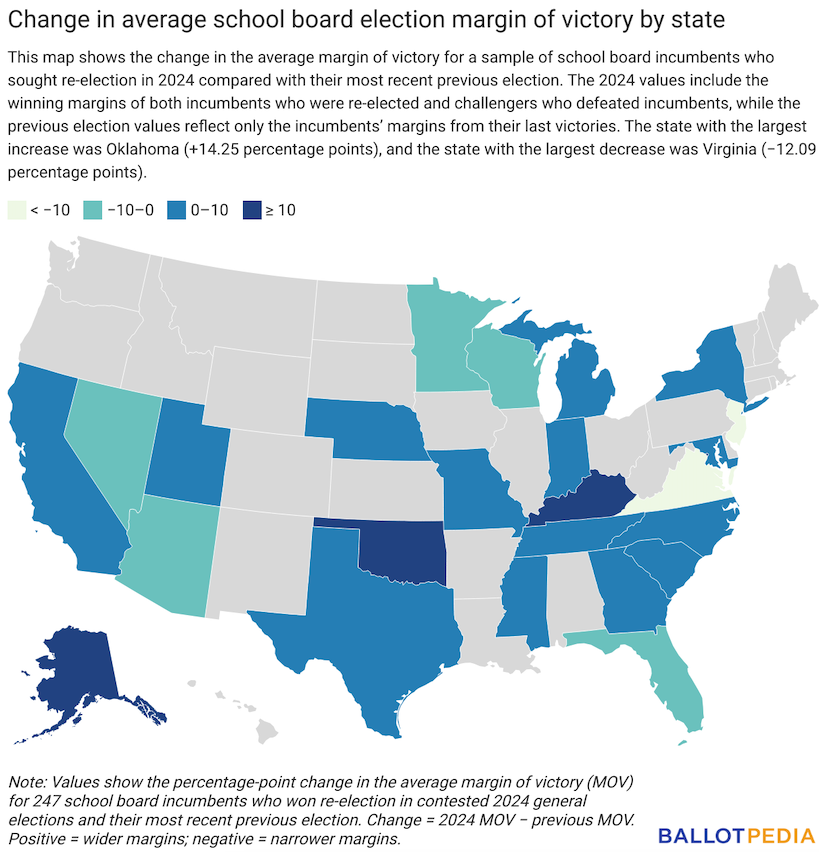How did school board incumbents fare in 2024 compared to their last elections?
Ballotpedia’s core school board election coverage includes the 200 largest school districts by student enrollment and the school districts that overlap the 100 largest cities by population. In 2024, we covered 1,058 seats up for election that fell within our core coverage scope. Those races, held in 29 states and Washington, D.C., featured 727 incumbents — 306 who lost, withdrew, or won outright in primaries and 421 who ran in general elections.
Of the 421 incumbents in this analysis, 337 (80%) ran in contested general elections, meaning they faced one or more opponents, while 84 (20%) faced no competition and were automatically re-elected. Roughly half of the contested elections in this analysis were decided by 10 percentage points or fewer.
Incumbents who were re-elected in contested general elections won by larger margins in 2024 than in their most recent previous races. In the 337 contested races, 247 incumbents won re-election. On average, those incumbents had an average margin of victory (MOV) of 16.1 percentage points—up from 13.9 percentage points in those same incumbents’ previous races. For the purposes of this analysis, in multi-seat races, the MOV for individual winning candidates is the difference between each winner's share of the vote and that of the top-placing losing candidate. About 30% of the incumbents in this analysis ran in multi-seat elections in which some number of at-large seats were on the ballot.
School board races featuring incumbents were generally more competitive than elections for other major U.S. offices
School board winners in the 337 contested elections—including both incumbents and challengers—won by narrower margins compared to those running in state legislative, U.S. House, and U.S. Senate elections.
- U.S. Senate: 16.9 percentage points for 34 seats.
- U.S. House: 27.3 percentage points for 435 seats.
- State legislatures: 27.3 percentage points for 5,807 seats.
- School boards: 14.7 percentage points for 64 seats

In 18 states, contested elections including incumbents were decided by larger margins than those incumbents’ previous races, regardless of whether incumbents held their seats or were defeated. In Oklahoma, for example, average margins rose from 25 percentage points in incumbents’ previous victories to 40 percentage points for all contested general elections in 2024.
In seven states, winning candidates’ margins were smaller than incumbents’ previous wins. In Virginia, average margins fell from 15 percentage points in incumbents' previous elections to 2.75 percentage points for all contested general elections in 2024.

Roughly half of contested races were decided by 10 percentage points or fewer in 2024
In 2024, 171 of the 337 contested races—or 51%—had a MOV of less than 10 percentage points. In the 421 incumbents’ previous elections, 52% were decided by 10 percentage points or fewer.
In the 247 contested races that incumbents won in 2024:
- Thirty-five percent were decided by 10 percentage points or fewer. The average MOV in those races was 4.3 percentage points.
- In those candidates’ most recent elections, ranging from 2016 to 2023, the average MOV was 7.3 percentage points.
In the 90 contested races that challengers won in 2024, 16% were decided by 10 percentage points or fewer. The average MOV in those races was 4.3 percentage points.
The most and least competitive races
Below, you’ll find the three elections in 2024 with the smallest MOVs:
- San Francisco Unified Board of Education, California: Incumbent Matt Alexander defeated John Jersin on Nov. 5 by a margin of .02%, or 248 votes. The election was for four at-large seats on the board. Alexander was the winner with the fewest votes, while Jerson was the loser with the most votes. Alexander’s previous election was in 2020, where he won by a margin of .5%.
- Millard Board of Education, Nebraska: Incumbent Amanda McGill Johnson defeated Allison Kinney-Walker by a margin of .004%, or 53 votes. The election was for three at-large seats. Johnson was the winner with the fewest votes, while Kinney-Walker was the loser with the most votes. In 2020, Johnson was uncontested.
- West Oso Independent School District, Texas: Challenger Albert Villarreal defeated incumbent Rose Marie Soto by a margin of .14%, or four votes. The election was for four at-large seats on the board. Villarreal was the winner with the fewest votes, while Marie Soto was the loser with the most votes. Marie Soto was previously appointed to the board.
Below, you’ll find the three elections with the largest MOVs:
- Riverside County Board of Education Trustee Area 4, California: Incumbent Bruce Dennis defeated Sergei Vinkov by a margin of 91%, or 39,264. Dennis was previously elected in 2020 with a 28.4% MOV.
- Garden Grove Unified School District Board of Education Trustee Area 5, California: Incumbent Dina Nguyen defeated Khai Dao by a margin of 76%, or 12,957 votes. Nguyen was previously elected with a 36% MOV in 2022.
- Eanes Independent School District, Place 4, Texas: Incumbent James Spradley defeated Robert Morrow by a margin of 72%, or 3,498 votes. Spradley was previously elected in 2021 with an 11% MOV.
Click here to learn more about 2024 school board incumbent election results and MOVs.


